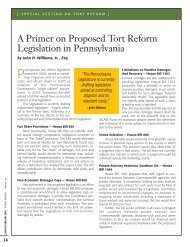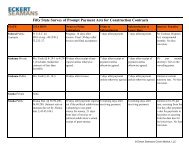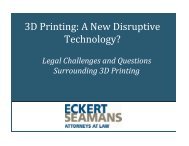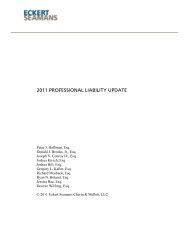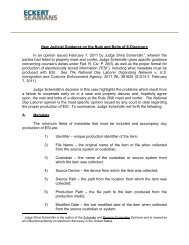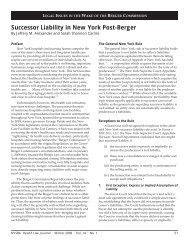2012 PROFESSIONAL LIABILITY UPDATE - Eckert Seamans
2012 PROFESSIONAL LIABILITY UPDATE - Eckert Seamans
2012 PROFESSIONAL LIABILITY UPDATE - Eckert Seamans
You also want an ePaper? Increase the reach of your titles
YUMPU automatically turns print PDFs into web optimized ePapers that Google loves.
In 1980, the Pennsylvania Superior Court recognized a second form of hospital liability.Capan v. Divine Providence Hosp., 430 A.2d 647 (Pa. Super. Ct. 1980). Under the ostensibleagency theory, a hospital may be held liable for the negligent acts of a staff member who is notan employee but, rather, an independent contractor. See generally Capan, 430 A.2d at 649.In finding Defendant hospital liable for the negligent acts of an independent contractorphysician, the Capan court recognized that “the changing role of the hospital in society creates alikelihood that patients will look to the institution rather than the individual physicians for care.”Id., at 649. The theory of ostensible agency is, therefore, premised upon two factors: (1) thepatient looks to the institution rather than the individual physician for care; and (2) the hospital“holds out” the physician as its employee. Id. A “holding out” occurs when the hospital acts oromits to act in some way which leads the patient to a reasonable belief that he is being treated bythe hospital or one of its employees. Id.The United States District Court for the Eastern District of Pennsylvania has held that afailure to deny agency does not rise to the level of “holding out”, particularly in a nonemergencyroom setting. Stipp v. Kim, 874 F. Supp. 663, 665 (E.D. Pa. 1995); see also Moralesv. Guarini, 57 F. Supp. 2d 150, (E.D. Pa. 1999; Whitehill v. Matthews, 40 Pa. D. & C. 4th 58(Del. Cty. Ct. Com. Pl. 1998).In Yacoub v. Lehigh Valley Medical Associates, P.C., 805 A.2d 579 (Pa. Super. Ct.2002), appeal denied, 825 A.2d 639 (Pa. 2003), the Pennsylvania Superior Court upheld the trialcourt’s decision to preclude Appellant from introducing evidence that Defendant radiologistswere ostensible agents of Appellee, Lehigh Valley Hospital, with respect to their interpretationof two radiological studies taken of Appellant’s decedent. Citing Goldberg, the Court held thatgiven the facts of this case, in order to impute liability on Lehigh Valley Hospital, not onlywould Appellant have had to show that the radiologists were negligent in reading the films atissue, but she would have also have been required to establish that such negligence contributed tothe neurosurgeons making a faulty diagnosis. Since it was ultimately the decision of theneurosurgeons to make the proper diagnosis and their conduct was found not to be a substantialfactor in causing Appellant’s harm, then the Court held that Appellant was precluded fromestablishing that the radiologists could have affected the jury’s determination as to causation.Under the MCARE Act, a hospital may be held vicariously liable for the acts of anotherhealth care provider through principles of ostensible agency if the evidence shows the following:1) a reasonably prudent person in the patient’s position would be justified in the belief that thecare in question was being rendered by the hospital or its agents; or 2) the care in question wasadvertised or otherwise represented to the patient as care being rendered by the hospital or itsagents. Further, evidence that a physician holds staff privileges at a hospital shall be insufficientto establish vicarious liability through principles of ostensible agency. See 40 Pa. Cons. Stat. §1303.516. The MCARE Act only applies to causes of action that arise on or after March 20,2002. For cases that fall before March 20, 2002, the subjective standard used in Capan v. DivineProvidence Hospital, 430 A.2d 647 (Pa. Super. Ct. 1980), applies.(c)EMTALA CASES58




